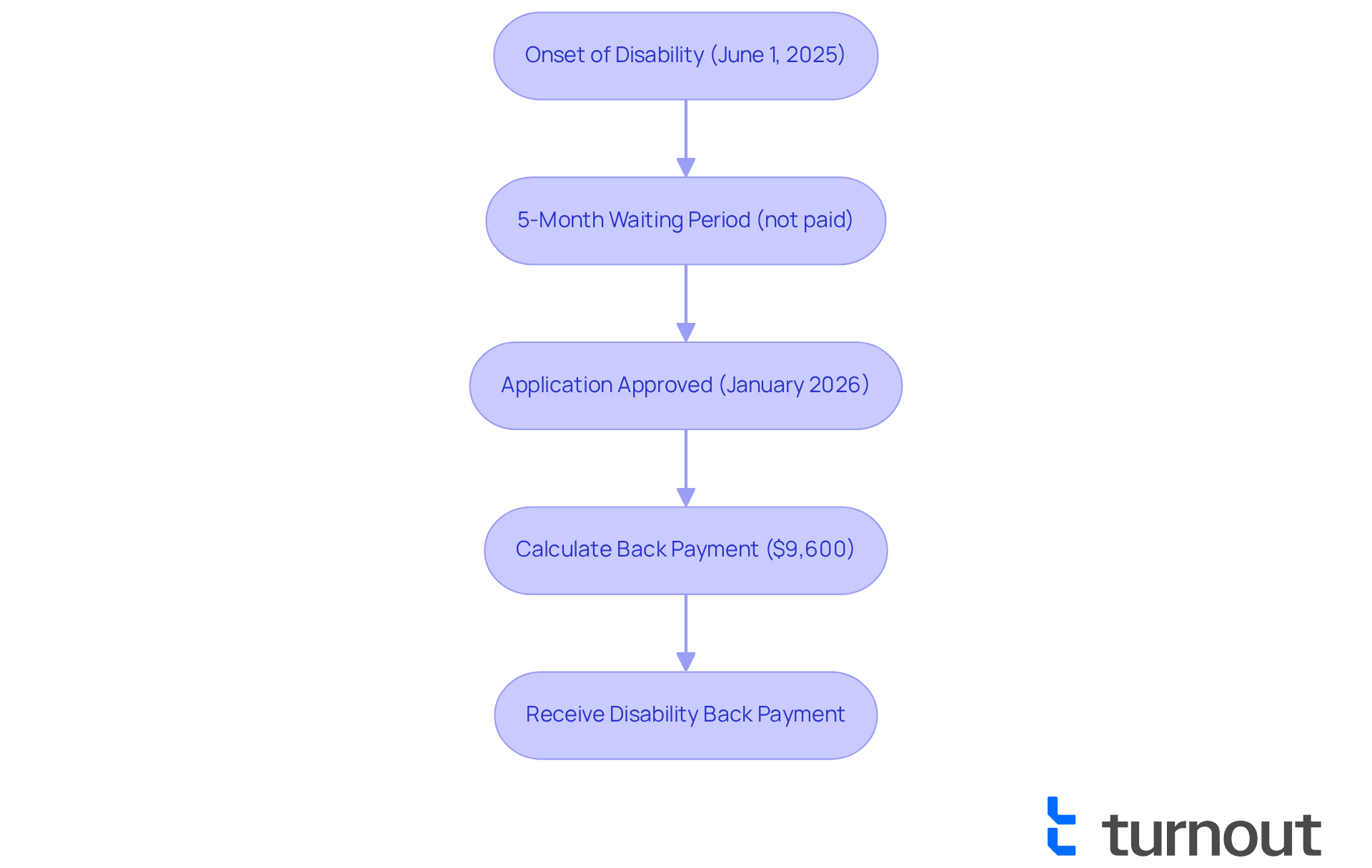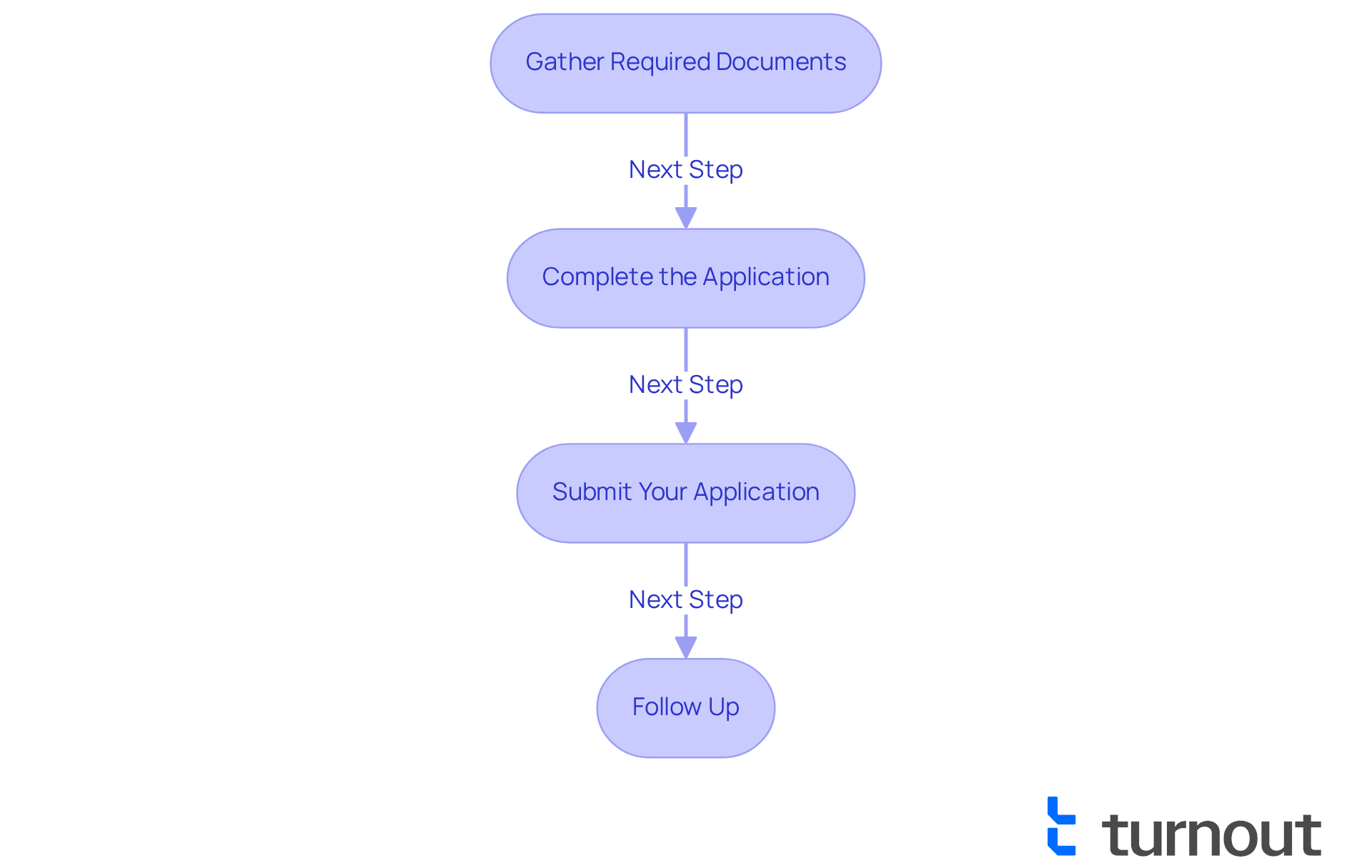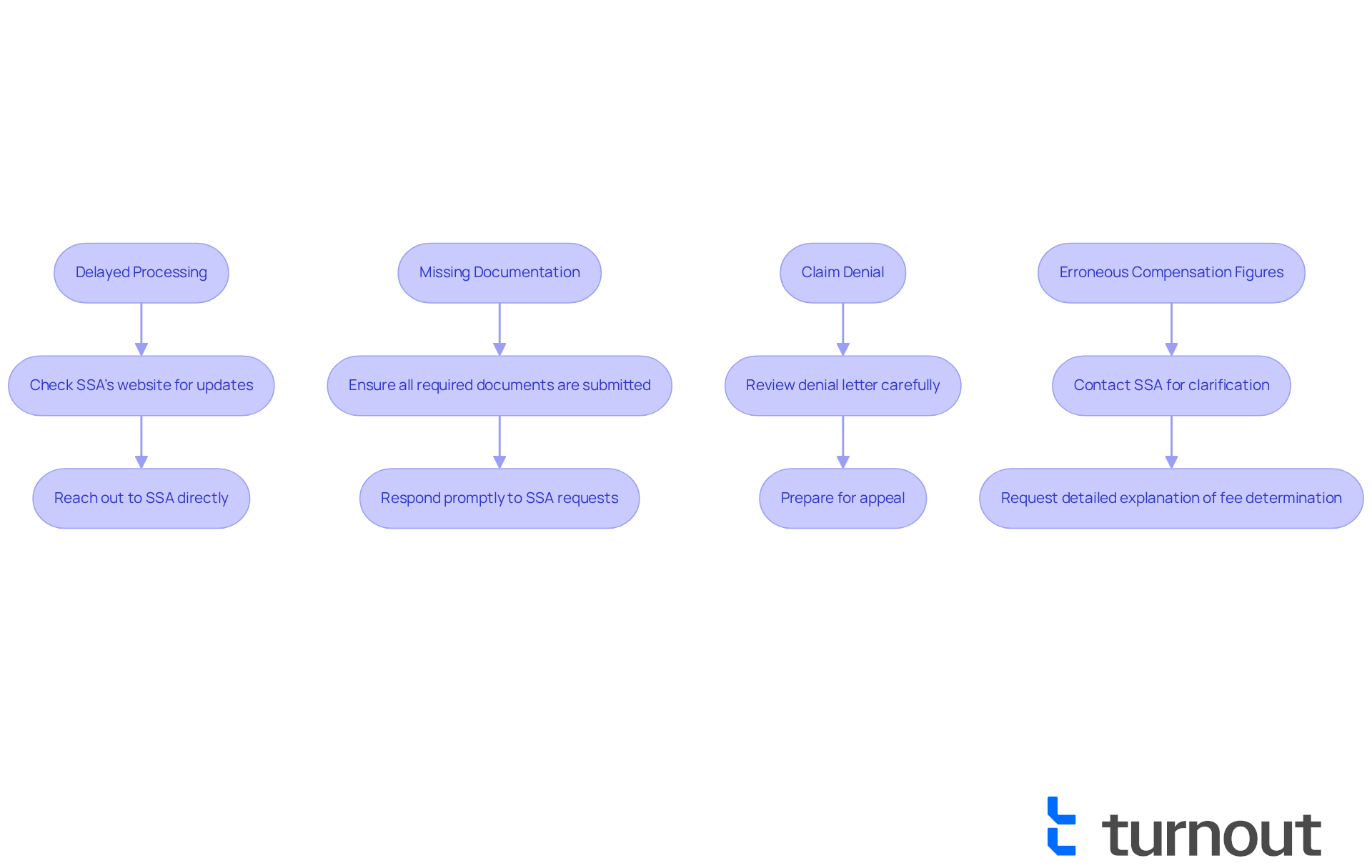Overview
This article serves as a compassionate step-by-step guide to help you navigate the complexities of mastering disability back payments from the Social Security Administration (SSA). We understand that the process can be overwhelming, and we’re here to support you every step of the way.
First, we will explore the eligibility criteria, ensuring you have a clear understanding of what is required. Next, we will walk you through the application process, addressing common hurdles you may encounter. It’s common to feel uncertain about how back payments are calculated, especially regarding the disability onset date and the five-month waiting period. This knowledge is crucial, as it can significantly impact your financial planning and the amount you ultimately receive.
We invite you to reflect on your own experiences as we provide you with the information you need. Remember, you are not alone in this journey. Together, we can work towards securing the benefits you deserve.
Introduction
Understanding the intricacies of disability back payments is crucial for anyone navigating the often complex landscape of social security benefits. We recognize that this journey can be overwhelming, especially for those facing hardships due to their disabilities. These payments can provide essential financial support, yet many remain unaware of how to effectively secure these funds. What happens when the process becomes too much to handle? What key factors determine eligibility and payment amounts?
This guide offers a step-by-step approach to mastering disability back payments. We’re here to empower you to take control of your financial future amidst challenging circumstances. You are not alone in this journey, and with the right information, you can navigate these complexities with confidence.
Understand Disability Back Payments
Compensation for past support includes the disability back payment you may receive from the Social Security Administration (SSA) once your claim is approved. These disbursements represent your disability back payment, covering the period from the onset of your disability until your application is approved. Understanding how these payments are calculated is important for your financial planning. Typically, the calculation for disability back payment begins from when you became disabled, minus a five-month waiting period. For example, if your disability began on June 1, 2025, and your application is approved in January 2026, you could receive reimbursements for the months from November 2025 to January 2026.
In 2025, the average retroactive payment for individuals was approximately $6,710. This amount can provide significant financial assistance during challenging times. It's essential to keep thorough records of your medical documentation and all communications with the SSA. These records will support your claim and help establish the accurate onset date of your condition.
Real-life examples highlight the importance of understanding compensation for disabilities. Consider an applicant with a confirmed onset date of January 2025 and approval in January 2026. This individual would receive $9,600 in disability back payment, which is calculated from the end of the five-month waiting period to the approval date. Such financial support can be crucial for those navigating the difficulties associated with their impairments.
Experts in the field stress the importance of grasping the details of compensation for past benefits. Clear communication and a solid understanding of the process can greatly affect your financial well-being during this time. By learning how these payments are determined and what amounts you might receive, you can better prepare for the financial implications of your condition. Remember, you are not alone in this journey, and we’re here to help you every step of the way.

Determine Your Eligibility for Back Payments
Understanding your qualification for disability back payment can feel overwhelming, but identifying your disability onset period—the moment your disability began—is crucial. This, along with meeting the Social Security Administration's (SSA) requirements for disability benefits, is key to your success. Let's break this down together.
-
Disability Onset: This is the moment when your medical condition started to significantly impact your ability to work. It’s essential for determining past compensation, as disability back payment can only be awarded retroactively from this point.
-
Submission Timestamp: This refers to when you submitted your application for disability benefits. The total amount you receive can be greatly affected by the calculation of the disability back payment, which is determined from the onset date to the approval date.
To receive disability back payment, you must be approved for Social Security Disability Insurance (SSDI) or Supplemental Security Income (SSI). If your application is denied, unfortunately, you will not receive any disability back payment as retroactive compensation.
It's important to remember that there is a mandatory five-month waiting period for SSDI claims, which affects when benefits start. For instance, if your impairment onset date is January 1, 2024, and you submit your application on March 1, 2024, your retroactive payments will be calculated based on the months between your onset date and your approval date, minus the waiting period. This means that if you are approved in January 2025, you may receive disability back payment for the six months leading up to your approval, but not for the five-month waiting period.
You might also qualify for larger first and second installments if you need immediate financial assistance, which can be crucial during the waiting period. To assess your eligibility, gather documentation that supports your claim of impairment, including medical records and work history. Remember, you are not alone in this journey. Turnout's trained non-legal advocates are here to help you navigate this process, ensuring you have the necessary documentation to build a strong case for receiving the funds you deserve.
As one supporter shared, "The process of determining your condition onset date can feel daunting, but having comprehensive records can greatly impact your claim's success." Moreover, it's essential to recognize that individuals with disabilities are over twice as likely as those without to live below the poverty threshold. This highlights the urgent need to secure the funds that are rightfully yours.

Submit Your Application for Back Payments
To submit your application for disability back payments, please follow these steps, knowing that we're here to support you through this process:
-
Gather Required Documents: Start by collecting all necessary documentation. This includes:
- Medical records detailing your condition and treatment history.
- Your work history for the past 15 years.
- Proof of income and resources.
- Your children's birth certificates and addresses if you're applying for extra benefits for eligible family members.
- Any other relevant documents that can support your claim.
-
Complete the Application: You can apply online through the SSA's website or visit your local SSA office. It's essential to fill out the application form accurately, providing all requested information. Remember, submitting a complete SSDI application is crucial to avoid delays and potential denial of disability back payment due to missing information. Turnout offers tools and services to help you navigate this process effectively, with trained nonlawyer advocates ready to assist you in preparing your application. Please keep in mind that Turnout is not a law firm, and the assistance provided does not constitute legal advice.
-
Submit Your Application: Once your application is complete, submit it along with all supporting documents. If you're applying online, follow the prompts to upload your documents. If you're applying in person, ensure you have copies of everything for your records.
-
Follow Up: After submission, it's important to keep track of your application status. You can do this online or by contacting the SSA. We understand that waiting can be stressful, so responding promptly to any requests for additional information is crucial to avoid delays in processing your claim. Turnout's expert guidance can help you stay informed throughout this process by providing support and resources tailored to your needs.
In recent years, over 45% of applicants have successfully submitted their claims online, highlighting the efficiency of the digital process. The average national wait time for a decision on SSDI applications is currently seven months, so it's essential to be patient. Real-life examples show that thorough preparation and timely follow-ups can significantly enhance the chances of approval. Keep in mind, benefits for impairments usually start five months following the onset of the condition for employees, which is important for understanding when you may receive financial assistance.

Troubleshoot Common Issues in the Claims Process
Navigating the process of seeking disability back payment can be challenging, and it's important to know you're not alone in this journey. Here’s how to troubleshoot some common issues you might face:
-
Delayed Processing: We understand that waiting for your application can be frustrating. If your application is taking longer than expected, check the SSA's website for updates or reach out to them directly. Delays often happen due to high volumes of applications or missing documentation. Remember, the average claim processing time can take up to 14 days, so a little patience is essential.
-
Missing Documentation: It’s crucial to ensure that all required documents are submitted. If the SSA requests additional information, respond promptly to avoid further delays. Many claims are denied due to incomplete submissions, so being thorough is key to your success.
-
Claim Denial: If your claim is denied, take a moment to review the denial letter carefully to understand the reasons behind it. You have the right to appeal the decision. It’s common for a significant percentage of claims to be initially denied, but many can be successfully appealed with additional evidence or documentation. Don’t lose hope!
-
Erroneous Compensation Figures: If you believe your disability back payment figure is inaccurate, don't hesitate to reach out to the SSA for clarification. They can provide a detailed explanation of how your fee was determined, ensuring transparency in the process.
By being proactive and informed, you can effectively navigate these common issues and increase your chances of receiving the back payments you deserve. Remember, we're here to help you through this process.

Conclusion
Understanding the intricacies of disability back payments is crucial for anyone navigating the Social Security Administration's (SSA) benefits system. We recognize that this journey can feel overwhelming. This guide has illuminated the essential steps to help you receive the financial support you deserve. From grasping the calculation methods to determining your eligibility and successfully submitting your application, you are not alone in this process.
Key insights include:
- The importance of accurately documenting your disability onset date
- Understanding the mandatory waiting period
- The necessity of diligently gathering and submitting the required paperwork
Real-life examples emphasize how thorough preparation can lead to significant financial support during challenging times. Clear communication and proper record-keeping throughout the claims process are essential.
Ultimately, securing disability back payments is not just about financial relief; it's a vital step toward achieving stability and independence for individuals facing disabilities. By taking proactive measures and staying informed, you can navigate potential pitfalls and increase your chances of a successful claim. Remember, support is available, and taking action today can pave the way for a more secure tomorrow. We're here to help you every step of the way.
Frequently Asked Questions
What are disability back payments?
Disability back payments are disbursements you may receive from the Social Security Administration (SSA) that cover the period from the onset of your disability until your application is approved.
How are disability back payments calculated?
The calculation for disability back payments begins from the onset date of your disability, minus a five-month waiting period. For example, if your disability started on June 1, 2025, and your application is approved in January 2026, you would receive payments for the months from November 2025 to January 2026.
What was the average retroactive payment for individuals in 2025?
In 2025, the average retroactive payment for individuals was approximately $6,710.
Why is it important to keep thorough records when applying for disability back payments?
Keeping thorough records of your medical documentation and all communications with the SSA is essential as they support your claim and help establish the accurate onset date of your condition.
Can you provide an example of how disability back payments work?
For instance, if an applicant has a confirmed onset date of January 2025 and their application is approved in January 2026, they would receive $9,600 in disability back payments, calculated from the end of the five-month waiting period to the approval date.
Why is it important to understand the details of compensation for past benefits?
Understanding the details of compensation for past benefits is crucial because it can greatly affect your financial well-being during the application process. Clear communication and knowledge of the payment process can help you prepare for the financial implications of your condition.




